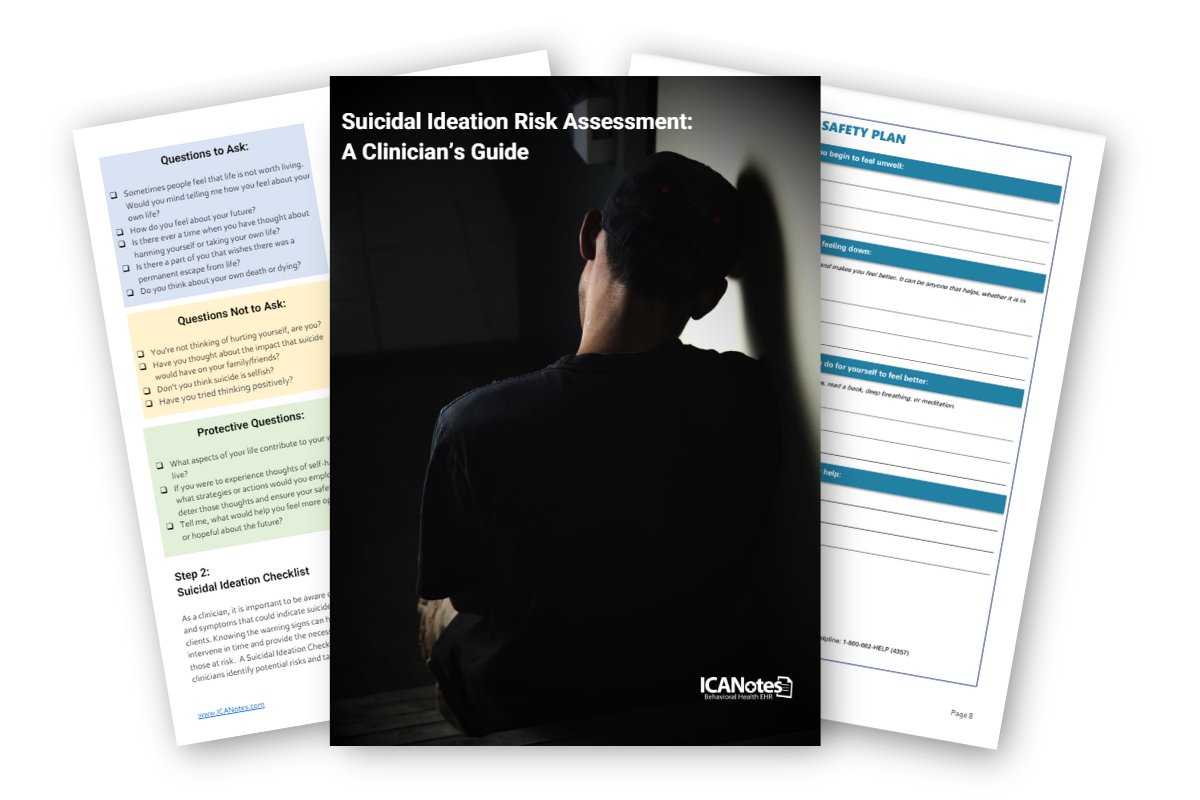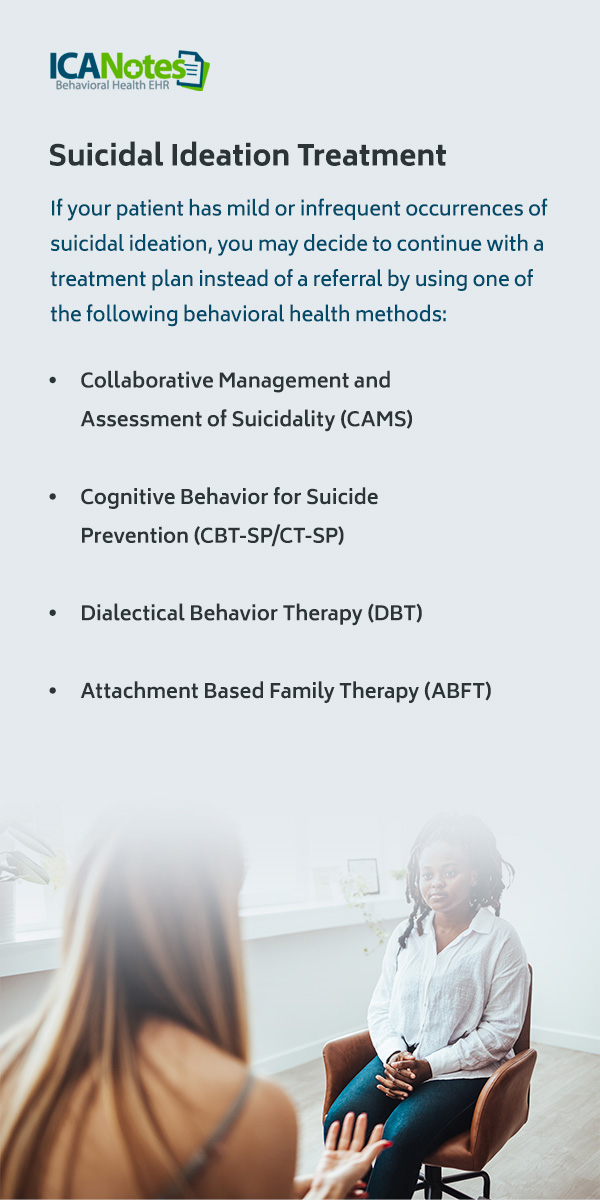
Assessing Suicidal Ideation
As a mental health therapist, treating clients with suicidal thoughts can be very intense and distressing, which is why it's important to know how to identify risk factors, symptoms and signs. According to the Centers for Disease Control and Prevention (CDC), one person dies by suicide every 11 minutes and over 12 million people thought about suicide in 2021.
This guide to talking about suicidal ideation as a therapist will give you the tools and treatment methods you need to counsel clients with suicidal ideation.
Exclusive Guide & Checklist
Suicidal Ideation Assessment Tools

Steps for Working With a Client Experiencing Suicidal Ideation
Suicidal ideation refers to any thoughts, feelings or visualization of one's suicide. These feelings can come in many shapes and forms. For some clients, these feelings can increase very gradually, whereas others may have an intense increase in suicidal thoughts from one day to the next.
Discussing suicidal ideation with your client can be stressful for some clinicians. Because suicide is a very delicate topic, it's best to form an intentional plan of action for bringing it up with your client and know how to address these concerns. Here are some tips and protocols you'll want to follow when counseling suicidal clients.
1. Know About Laws and Protocols
The first step to counseling a client with suicidal ideation is to know the legal and ethical requirements of a mental health professional. Be sure to review your state and federal laws for reporting thoughts and intentions of suicide in your clients. In some states, you may be required to report to the authorities if your client is expressing suicidal thoughts or if they are a threat to themselves or others. This is known as a duty to protect or warn.
You may also have to disclose this information to certain insurance companies who require it for billing purposes, but this usually only requires very limited information, such as their diagnosis, treatment goals, and session dates. While most therapy sessions have strict confidentiality, reporting suicidal behaviors, symptoms or thoughts is sometimes necessary to maintain the client's safety and provide the care they need. If you're unsure about the laws and protocols in your state, reach out to your supervisor to ensure you follow reporting procedures correctly.

2. Know How to Ask
While asking about suicide may feel awkward and uncomfortable at first, it's essential to know how to ask about these thoughts and feelings if your clients display certain behaviors. Suicide is broken down into three parts — ideation, intent and plan. It can be difficult to determine if your client is at the stage of ideation, where there may only be subtle signs, so making a habit of asking your clients about their thoughts can make these conversations more comfortable.
Some clients may never reach the intent stage, while others can go from suicidal ideation to forming ideas for how to carry out suicide within the same day.
Asking the right questions allows you to notice these changes in your clients and engage in treatment and safety planning activities to decrease risk. Here are some questions you'll want to ask your clients if you suspect they may be struggling with suicidal ideation:
- Are you having any thoughts of suicide or self-harm?
- When did you begin to have suicidal thoughts?
- How often do you have these thoughts?
- Did a specific event or stressor lead to these suicidal thoughts?
- On a scale of 1-10, how intense are these thoughts when they happen?
- Do you have a plan to end your life?
- What makes you feel better when you have these thoughts?
- What makes you feel worse?
- How much control over your suicidal ideas do you have? Can you suppress them or call someone for help?
- When you think about ending your life, what do you imagine?
- Do you have access to potentially harmful medications or firearms?
Depending on how the client answers these questions, you may want to contact and interview a family member, significant other or loved one to help minimize these symptoms and keep their families involved.
Watch our on-demand webinar to learn how to confidently navigate conversations about suicidal ideation
3. Know About Suicide vs. Self-Harm
As a behavioral health professional, it's important to know how to differentiate suicide from self-harm, which is often referred to as non-suicidal self-injury (NSSI). Some clients who self-harm may not necessarily wish to end their life or have an intent or plan to do so. Other clients may have a desire to self-harm to gain confidence toward their eventual goal of death.
However, both of these behaviors fall under a broad umbrella, which can make it challenging for some therapists to recognize the difference. Self-harming by itself is often seen as a coping mechanism for emotional pain, stress, helplessness or reactive violence against oneself after enduring abuse. Some behaviors that are considered self-harm include:
- Cutting of the skin
- Hair-pulling
- Burning
- Bruising oneself
- Initiating physical violence or conflict
- Hitting or beating oneself or objects
If your client admits to any of these behaviors, you must not rule out suicidal ideation or intention. Clients who are motivated to harm themselves may be more likely to have the desire to end their lives if their emotional distress is left untreated.
4. Conduct a General Suicidal Ideation Questionnaire

Mental health professionals can use an evidence-based suicidal ideation questionnaire to assess suicide risk in individual clients. Though there are several types of suicidal ideation checklists, here are some general factors to use as a reference for your clients.
- Feeling trapped
- Persistent feelings of hopelessness
- Expressing beliefs that life is not worth living
- Increased drug or alcohol consumption
- Significant or abnormal changes in sleep patterns
- Significant or abnormal changes in eating habits
- Withdrawal from friends and family
- Formulation of suicide plans
- Giving away possessions
- The belief that everyone is against them
- Feeling targeted or bullied by others
- Persistent and intense feelings of depression
- Frequent anxiety or panic attacks
- Loss of interest in hobbies
- Engaging in reckless behavior
- Feeling a profound sense of unworthiness
- Expressing a desire for revenge against those who have harmed them
- Feeling that life lacks meaning
- Unusual happiness or calmness after a period of depression
- Extreme mood swings
- Listening to sad music
- Actively pursuing methods to end their life
Use this template to evaluate your client and their level of risk. If your client's behavior aligns with several or all of the above criteria, then they are likely at high risk for suicide. This can help you create an immediate intervention strategy to get your clients the care they need.
5. Perform a Suicidal Ideation Scale Test
Once you've gathered a general idea of your client's suicidal ideation, you can use several official screening tools to assess the severity of their risk.
Suicidal Ideation Attributes Scale (SIDAS)

The SIDAS is a common screening tool mental health professionals use to score their clients based on a 10-point scale. Clients whose answers are closer to 0 present less risk than clients whose answers are closer to 10. Clients assign scores to the following questions:
- In the past month, how often have you had thoughts about suicide?
- In the past month, how much control have you had over these thoughts?
- In the past month, how close have you come to making a suicide attempt?
- In the past month, to what extent have you felt tormented by thoughts about suicide?
- In the past month, how much have thoughts about suicide interfered with your ability to carry out daily activities, such as work, household tasks or social activities?
Columbia Suicide Severity Rating Scale (C-SSRS)
The C-SSRS consists of the following questions:
- Have you wished you were dead or wished you could go to sleep and not wake up?
- Have you actually had any thoughts about killing yourself?
If your client answers yes to these questions, proceed with the following questions:
- Have you been thinking about how you might do this?
- Have you had at least some intention of acting on these thoughts?
- Have you started to work out or worked out the details of how to kill yourself? Did you intend to carry out this plan?
- Have you done anything, started to do anything or prepared to do anything to end your life?
Suicidal Affect-Behavior-Cognition Scale (SABCS)
The SABCS consists of the following questions that clients will answer on a scale of “never” to “very often," “very much” or “very likely.”
- Have you ever thought about or attempted to kill yourself?
- How often have you thought about killing yourself in the past year?
- In the past year, have you had an internal debate about whether to live or die?
- Right now, how much do you wish to live?
- How likely is it that you will attempt suicide at some point?
6. Know About Protective Factors
The next step to counseling your client with suicidal ideation is to identify protective factors that can act as a buffer from suicidal thoughts and feelings. While risk factors are most commonly referenced, protective factors are just as important for guiding your client through their treatment. According to the CDC, some protective factors that can protect against suicide risk include:
- Coping and problem-solving skills
- Family, friends or romantic relationships
- Support from loved ones
- Feeling connected to a community
- Passion for a career
- Strong sense of cultural identity
- Availability and access to behavioral healthcare
- Moral or religious objections to suicide
- Reduced access to lethal means of suicide
- Pets
- Instincts for self-preservation
- Stress and frustration tolerance
- Goals and dreams
If you're struggling to determine a client's protective factors, try asking open-ended questions to help them reflect on the positive, supportive aspects of their life, such as:
- In the past, when you have thought about ending your life, what has prevented you from doing so?
- What are the things that make you feel safe?
- In the past, what activities have helped lift your spirits?
- Who are the people in your life that make you feel happy and support you?
From here, you'll want to discuss with your client which protective factors can be enhanced to increase their safety. For instance, if your client feels that a certain hobby sparks their happiness, what can they change to dedicate more time to that hobby?

7. Know About Risk Factors
Risk factors are one of the first things you may notice about a client who has admitted to having suicidal ideation. By assessing these risks, you can deliver better treatment to your client and alleviate their symptoms. Here are the most common risk factors associated with completed suicide:
- Widowed or divorced
- Living alone
- Stressful life events, such as divorce or the death of a loved one
- Access to firearms
- Major depression
- Panic disorder
- Insomnia
- Severe anxiety
- Substance abuse
- Borderline personality disorder
- History of suicide attempts
- Family history of suicide
- Childhood trauma or abuse
- Domestic violence
- Social isolation
- Medical health diagnosis
- Financial debt
- Feelings of purposelessness
- Feeling trapped
Keep in mind that certain demographics and groups have higher rates of suicide than others, which is necessary to consider during your suicide risk evaluation. Suicide rates can vary widely depending on a person's age, race, ethnicity, sexual orientation, occupation or location. For example, veterans, middle-aged adults, tribal populations, those who live in rural areas, and sexual and gender minorities may experience risk factors linked to suicide significantly more than other groups.
Non-Hispanic white men aged 75 or older also have the highest risk compared to other age groups. Keep these risk factors in mind when meeting with your clients to determine if they might have a higher risk of thinking about or attempting suicide.
8. Know About Your Resources
Some clients may not admit to suicidal ideation. They may feel uncomfortable talking about such feelings out loud or afraid that you may contact their loved ones and tell them. Many people who have thoughts of suicide may not want to share these feelings with anyone at all, but it's important that you communicate calmly that therapy is a place for them to express these kinds of thoughts and feelings.
Or, if a client is willing to admit that they have suicidal ideation, but unwilling to commit to a safety or treatment plan, you may have to change your course of action and refer them to another service.
Once you identify the necessary protective and risk factors and conduct your assessment, it's important to know that you have resources as a behavioral health professional to help keep your client safe. Aside from building your relationship with your client and clearly communicating your desire to help them, you also have access to more intensive care options like:
- Emergency department: You can send your at-risk client to be evaluated by a behaviorist at a Hospital Emergency Department (ED), where they can stabilize your client and coordinate care. If necessary, local law enforcement can provide transportation for your client to the ED if they are in the midst of a psychiatric crisis. It's wise to check if your state, city or county has a mental health dispatch that can respond in a trauma-informed way since having emergency personnel called during a crisis is already a traumatizing experience for many.
- Acute inpatient hospitalization: For clients with high-risk suicidal factors, inpatient care is a top-tier option. This level of care offers stabilization, medication management, social work services and interventions. If the client is a risk to themselves or others, they are more likely to qualify for inpatient care. The acute hospital usually has an intake or assessment office where they will determine whether an individual is admitted.
- Day program: If your client does not quite meet the criteria for inpatient hospitalization, a day program may be an ideal fit. Your client may benefit from this around-the-clock psychiatric treatment and observation if they are at risk but still have strong self-managing abilities or support.
- Respite care: If your client's suicidal ideation is brought on by an event or stressor at home, they may qualify for respite care, which allows them to take some time away and benefit from regular check-ins and learn medication compliance. However, there are often long waitlists associated with respite care, so relief might not be immediate depending on the client's state, county or region.
- Community or religious services: Some suicidal clients may improve when they feel supported and part of a community. Determine if your client could benefit from receiving local services for assistance outside of their sessions with you.
Regardless of how your session unfolds with your client, it's absolutely vital to clearly and thoroughly document each session. Be sure to note your client's protective and risk factors, their support system, the number of local crisis centers that you provide, and any other necessary factors you find during your evaluation. If your client denies feeling suicidal or having suicidal ideation, document their denial and any reason why you may believe they are high-risk.
9. Determine Interventions
Review the resources you have at your disposal. If your client is not in crisis mode and is willing to engage in the treatment, discuss their options with them. You and your client may decide on more frequent sessions, for example, rather than seeking respite care. They may allow you to communicate with their loved ones or emergency contacts about enhancing protective factors and discussing a plan for suicide precautions.
Something as minor as providing your clients with mental health crisis numbers can provide relief for them if they feel intense suicidal ideation and cannot contact you outside of business hours. However, if your client is in a severe crisis, you may want to immediately refer them to inpatient hospitalization or the ED.
Regardless, the intervention and treatment plan you devise will be based on your state and federal laws, your organization or practice policies, and your consultation with your clinical lead or supervisor. Your practice may also consult an outside organization during mental health crises. You'll also want to provide follow-up services, such as contacting and consulting your client's current care team or services to determine long-term treatment.
Suicidal Ideation Treatment
If your client has mild or infrequent occurrences of suicidal ideation, you may decide to continue with a treatment plan instead of a referral by using one of the following behavioral health methods:
- Collaborative Management and Assessment of Suicidality (CAMS): This therapeutic framework helps individuals determine the issues that lead to suicidal ideation with the goal of developing an effective stabilization plan to manage these drivers. It also helps clients engage with reasons for living.
- Cognitive Behavior for Suicide Prevention (CBT-SP/CT-SP): This therapy model is focused on preventing suicidal crises by restructuring the way the client thinks and responds to their automatic thoughts. By separating thought-behavior-mood patterns, individuals can cope more effectively, improve decision making and work toward activities that enhance their lives.
- Dialectical Behavior Therapy (DBT): The goals of DBT are to focus on the interaction between a client's environment and their biological functions that impact behavioral control and emotional regulation. DBT aims to help clients feel that their life is worth living by reinforcing mindfulness, decreasing feelings of being overwhelmed, acknowledging reality and promoting social skills.
- Attachment-Based Family Therapy (ABFT): This treatment method seeks to reduce an individual's suicide risk by validating their emotional experiences and helping them accept negative emotions, resolve conflicts with compromise and improve communication within families. ABFT aims to help family members feel more comfortable discussing difficult feelings and solving problems together.

Find Out How ICANotes Can Help You Help Your Clients
Counseling clients with suicidal ideation can be stressful, especially when developing the right interventions and treatment plans to get your clients the help they need. Because suicidal thoughts and risk factors come in many shapes and forms, it's vital to keep each session well-documented so you can review organized, thorough notes before you begin a new session.
With ICANotes, you can keep your therapy treatment plans and progress notes well-structured and legible, so you and other necessary behavioral health professionals can spend less time on documentation and more time delivering care to your clients. Dealing with a crisis like suicidal ideation requires your entire focus.
ICANotes helps you provide more comprehensive care and enables you to easily make adjustments to your clinical interventions and treatment plans. Contact us today to learn more about how our note-taking templates can help you monitor your clients or request a free trial online.


